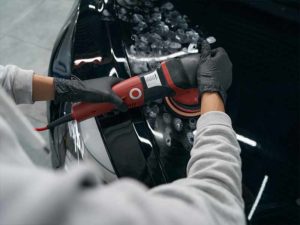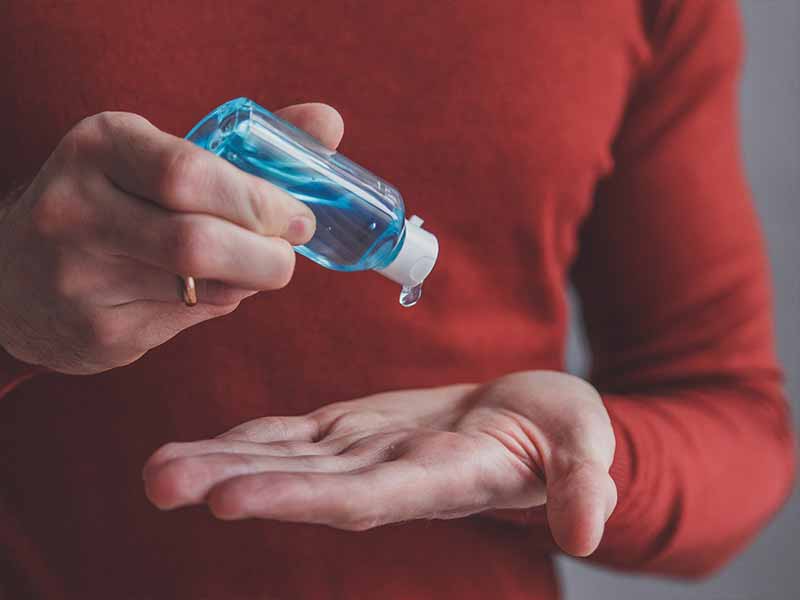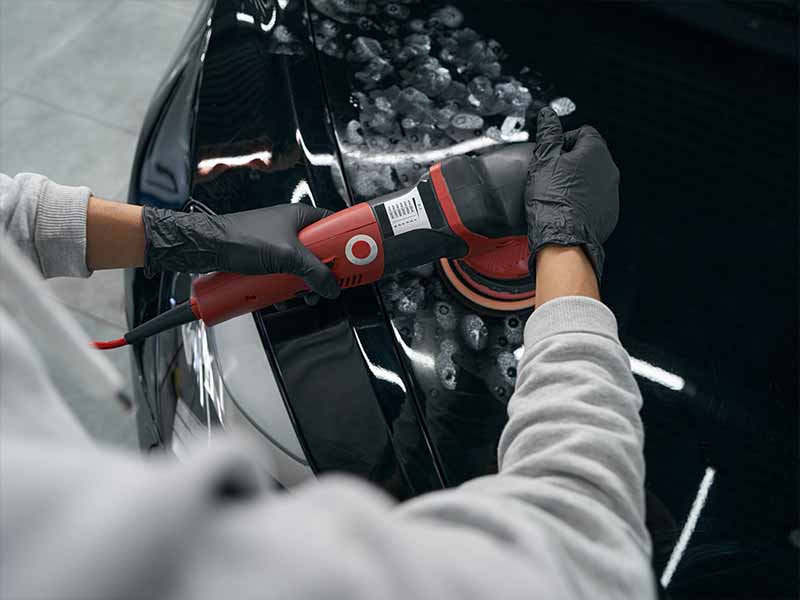Table of Contents
Plenty of DIY detailers are using cleaner waxes and not even realizing it. A large group of consumers doesn’t know that cleaner waxes exist in the first place. To clear things up, we’re going to talk all about cleaner waxes and traditional waxes. More specifically, we’ll work through the differences and uses between cleaner wax vs wax.
Cleaner Wax Vs Finishing Wax
A carnauba wax or paint sealant provides protection and shine for your finish. A cleaner wax does this as well but is also designed to remove adhered contaminants from the vehicle surface as well as remove old wax.

The Differences Between Cleaner Wax and Finishing Wax
At this point, you can probably list the differences between these two options. In an effort to give you the full section, we put together this section. Here are the biggest differences between cleaner wax and wax.
The Ability to Clean
The biggest difference between the two is the ability to clean. Standard waxes don’t have any abrasives or decontaminants, so there is no ability for them to clean your car. Cleaning waxes have these components so they will decontaminate your paintwork.
How Long it Lasts
Since cleaner waxes also include cleaning agents, it doesn’t have the best longevity. As such, traditional waxes will last a lot longer.
By that, we mean that a layer of traditional wax on your car will leave your car protected and shiny for longer.
How Shiny it Makes Your Car
In addition, a standard wax will also make your car look shinier. This goes back to the fact that a wax has a single focus and a cleaner wax has to do two things at once.
What Is Wax?
A wax, whether carnauba, paint sealant, or hybrid, is a product that gets applied to your car to make it shinier and help protect the finish from road grime, environmental contaminants, and the weather.
The wax itself can be found as a paste, liquid, or spray. In any of these three forms, it will be applied to your car, typically buffed, and then allowed to dry. After this process, your car will look showroom-ready.
Wax was first invented back in the 1800s. Back then, it was made from animal fats and it was used to protect the paint on products like horse carriages. Today, you can find a number of waxes that protect different products. In this article, we’re going to focus on automotive waxes that are used on vehicles.
Main Reasons to use Wax or Paint Sealant
We mentioned some of the major uses of waxes already, but we should be more specific. These are some of the biggest reasons why people apply wax to their car.
Adds Protection
Wax is a protective layer between your car’s topcoat and the outside world. It’s very difficult and expensive to repaint your car or truck, so wax is the less expensive alternative to ensure your paint stays safe.
Vehicles that don’t keep a protective wax or paint sealant on the finish will see the clear coat begin to become hazy and eventually start peeling.
Adds Gloss
A lot of people will apply wax just to make their car shinier. This is what dealerships often do for their cars in the showroom. You’ll also notice waxes cars at auctions, car shows, and in museums. It gives a level of shine that simply isn’t possible with just a wash.
Makes Car Washes Easier
Waxes and paint sealants are hydrophobic, meaning water beads and rolls off them. This takes dirt and other road and environmental contaminants away with it. It also makes it difficult for the dirt and contaminants that don’t roll off with the water to adhere to the paintwork, making washing easier.

What Is Cleaner Wax?
Cleaner wax can also be called one-step wax or all-in-one wax. It’s the “shampoo and conditioner” of the automotive wax world. Instead of just waxing your car, it also cleans it.
It takes the traditional makeup of wax and adds in abrasives, solvents, and different cleaning agents.
The idea is that you can use this single product and achieve two completely different tasks. Instead of performing a full car washing followed by a waxing, you can just apply this wax.
In fact, most of the major waxes on the market for DIY consumers are actually cleaner waxes. Unless the label specifically just says traditional wax, it’s a good bet that there are cleaners included in their product.
It all comes down to what the customer wants. Since cleaner waxes are much easier and more convenient, companies tend to focus on this for the everyday detailer. Plus, most car owners aren’t going to buy a suite of products when there’s one that can do multiple functions.
Advantages of Cleaner Wax
A lot of people still use cleaner waxes. Why? There are a lot of great reasons.
Cleans Off Old Wax
If you use standard wax, you need to start by cleaning off the old layer of wax. This is the only way to use a paint cleaner, and it involves two steps that you can skip if you use a cleaner wax instead.
The all-in-one wax requires only a single step: apply the wax.
Does the Prep for You
Another headache of waxing is the preparation you need to do. You’ll have to perform a thorough carwash before waxing your car, to ensure dirt doesn’t get in the way.
Oftentimes, this means taking twice as long and using at least double the number of products.
This is where cleaner wax comes in handy. Instead, you just apply this layer of wax and you don’t have to worry about cleaning your car.
It’s More Convenient and Easier
Along the same vein, cleaner wax is a lot easier to use and more convenient. This is largely due to the fact that you don’t have to worry about removing old wax or doing any prep work.
Instead of three separate products and steps, you do it all with one.
Saves a Lot of Time
Not only are you saving the hassle of all these steps, but you’re also saving time. It’s not uncommon for things to take a third or half as long as they otherwise would, as long as you use a cleaner wax.
This form of cleaning, polishing, and waxing is favored by a lot of people. The everyday driver is looking to save time and effort when it comes to detailing their car, and this is where cleaner waxes stand out.
Increased Clarity
Cleaner waxes are made to decontaminate your car and lightly polish it. Doing this will smooth the edges of any surface imperfections like scratches or swirls. This light surface polish will remove oxidation and restore clarity to a neglected finish.
That means that fine scratches, swirls, and light oxidation will seemingly disappear, leaving you with a car that has better shine and gloss.
Decreases the Number of Detailing Products You Need
You’ll also have fewer products in your garage. The more you get into detailing, the more products you will buy and manage. With a cleaner wax, you get a general-purpose cleaner, wax, and polisher in a single bottle.
No more juggling different products and understanding which option is right for certain situations.

Disadvantages of Cleaner Wax
As great as cleaner waxes are, they have some drawbacks. This might discourage some people from using it and instead opting for a traditional waxer.
The Problem with 2-in-1
Since cleaner waxes need to perform multiple functions, they aren’t the best performer in each of the actions. In other words, a cleaner wax isn’t the best cleaner or waxing product on the market. The key difference is that it does both things at once.
A good cleaning agent will get your car cleaner, and a good wax will wax your car better than a cleaner wax.
This is the same with most 2-in-1 products. The appeal is that they do both things, not that they’re the best performer at either function.
Not as Durable
Durability defines how long your car is protected, shiny, and sealed with wax. Cleaner waxes don’t last as long on your car as traditional waxes, so they’re not as durable.
It also means that they are more susceptible to scratches than a traditional wax. It will still give you better protection than your topcoat alone, but it can’t compare to a regular wax.
Uses Harsher Chemicals
To achieve the dual-functionality of a cleaner wax, the manufacturer needs to use harsher chemicals. As long as you still apply the product correctly, this shouldn’t be an issue.
The only problem is for people who are looking for natural options. In general, natural cleaner waxes can’t measure up to the synthetic options. This means that you’ll need to settle for using harsher chemicals if you want the best results.
Can Cause Stains
A big downside of these harsher chemicals is that you can stain the trim and plastic around your car. The worst part? It’s very hard to get rid of the stain on your car’s plastic.
A lot of users will mask off the plastic and work especially careful to avoid this happening. For liquid cleaner waxes, it’s easy to make a mistake and get the solution where it doesn’t belong.
You Still Need a Polisher
A majority of cleaner waxes are liquid. Some customers think this means they don’t need to use a polisher.
If you want the best results, you should still use a dual action polisher. The same is true for traditional waxes.
Traditional waxes are typically also liquids. The paste waxes are the only ones that should be applied by hand, all others should use a polisher. Luckily, this tool is easy to learn and use.

How Does Car Wax Work, In General?
A lot of people are familiar with waxing a car, but do you know what’s going on behind the scenes? It starts with applying the wax. It sticks to the topcoat of your car and starts to dry.
After it’s dry, it fills in the gaps and creates a layer on top of your car’s topcoat. From there, you’ll use a buffing machine and hone down the layer. The goal is to have a very thin, uniform layer of this compound.
Wax is designed to have protective properties. One of its main purposes is to preserve your car’s topcoat. It protects against scratches, UV damage, and road debris as you drive along.
A good wax will also make your car look shinier. The solution is designed with solvents and oils that are reflective and glossy.
A big downside of wax is that it isn’t permanent. After enough time, the wax will wear away and you’ll have to reapply it. You can use a synthetic paint sealant will last longer. Sealants retain most of the gloss and shine of natural carnauba waxes but not only last much longer, protect significantly better.
Different Types of Wax
There are nearly a dozen different types of waxes on the market. Some are made specifically for tires, others are for finishing, and even waxes that are designed to accentuate your car’s base paint color.
Under the umbrella of “traditional wax”, you’ll find either natural or hybrid options. Similar to products at your grocery store, natural wax utilizes ingredients like Carnauba, beeswax, and oils (natural ingredients).
Hybrid options will combine natural ingredients with synthetic (or man-made/ engineered) materials. Most notably, you’ll find chemicals like silicones, polymers, and petroleum-based resins.
For the sake of argument, we’ll clump both of these together and call them “traditional waxes”. On the opposing side is cleaner waxes — a similar product that works in a very different manner.

Helpful Links
Conclusion
Understanding the differences between cleaner wax and wax is the first step to picking the right product.
If you don’t mind spending extra time and effort, there’s nothing wrong with washing your car then waxing it afterward. For consumers who want quick results and extra ease, you should opt for a cleaner wax. For more
DIY detailing guides, here’s our blog.









